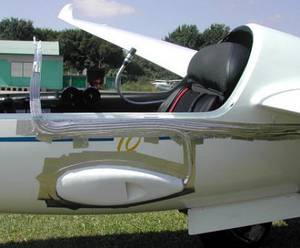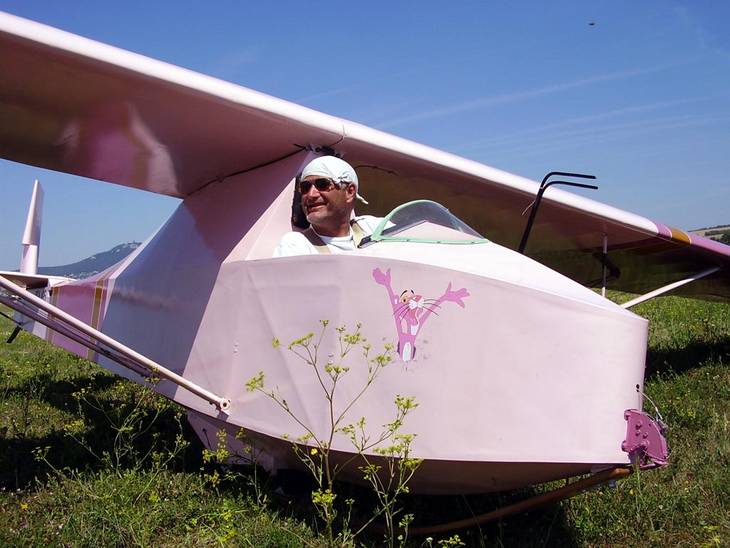How to achieve a dramatic increase
in a glider’s performance with a simple measure
Patent pending!
Background:
Where does the air go that comes into the cockpit through the vents?
This is by no means a new question.
- Wolf Lemke specifically designed the fins of LS gliders with an opening which was supposed to allow the air to exit without causing major damage to the airflow. However, he never measured the effect.
- Schleicher gliders have a similar opening in the fin.
- Our CEO Holger Back remembers that Klaus Holighaus once said to one of his fellow team members in a competition that “if it gets tough, shut the vent!”
- I also asked Wilhelm Dirks this question years ago and was told that the fuselage of the DG-808 is virtually open at the tail, allowing an unhindered exit for the air.
- Nobody however investigated any further and tried to find out what really happens and how one might be able to influence it.
Only when Holger Back and Stefan Dörnemann talked to our engineer Clemens Mandl about this issue and asked him what his thoughts were, Clemens thought of various ways of testing the effect of the airflow and came up with astonishing results.
Air flow:
First of all Clemens Mandl (who is responsible for the detailed design of the LS10) worked out whether the pressure in the LS10’s cockpit actually changes when you open or close the vent. The result was that opening the vent caused an increase in pressure of e.g. 0.5mb at 110kph (54kts) and 2mb at 200kph (108kts). This proves that the incoming air cannot exit the aircraft without resistance.
As described, LS gliders have a 40mm diameter opening in the back of the tail fin. The idea was that the air flows out of this opening and around the rudder. This however can’t really work as there is a mylar seal on the rudder. The air will therefore be deflected to the top and bottom. What Clemens noticed next was that when he moved the stick back, i.e. when he generated a lower pressure on the underside of the elevator, there was a gurgling-whistling noise in flight. This was the air causing the top mylar seal to vibrate. Aha!
It was also fairly clear that some of the air will find its way into the wings. On the DG-808 with its torsion rods for the ailerons the wings are sealed “airtight”. (Wilhelm Dirks knew about this phenomenon!) On the LS10 and other gliders with the automatic “Hänle” control connections such an airtight seal is not possible. Some of the cockpit air therefore has to flow out at the aileron connections and cause vortices.
Everybody knows that flies disturb the laminar profile. But what about the canopy frame? The canopy gap is much bigger than a fly and can never be fitted so accurately that it would not have an impact on the laminar airflow. Could it even be that the cockpit air escapes through the canopy gap and causes the – at that point still laminar – airflow to become turbulent over a large area? This question had also been asked in the past, with the consequence that at one Worlds some pilots had their canopy gaps taped after getting in. Luckily this dangerous activity was soon banned.
Anyway, we see that the cockpit air is definitely responsible for “aerodynamic disaster”
The Mandl Air Extractor
It doesn’t happen very often, but sometimes an innovative person has an idea for solving a long-known problem, which is so simple that everybody else wonders why nobody else thought of this before. In hindsight it is such an obvious solution.
Clemens Mandl asked himself the following simple question:
How can I guide the cockpit air outside in such a way that it
- can flow out without causing any undesired high pressure,
- and indeed causes a lower pressure which improves the flow
- and as a side effect improves the effectiveness of the vent for the pilot?
The result is the “Mandl air extractor” – named in honour of its inventor:
You probably know of the principle of the NACA ducts, air inlets in the fuselage through which the air is supposed to flow inside without greatly disturbing the airflow on the outside.
Well, analogous to this system, Clemens has developed an air outlet and found a location on one side under the fuselage where the air flowing past on the outside generates a lower pressure and practically sucks the air out of the cockpit.
The first test was supposed to show whether it was possible to build an outlet which causes a lower pressure.
This was done with a makeshift solution as can be seen on the picture. The result was that at various different speeds there really was a lower pressure, from 1.5mb at 80kph (43kts) to 5mb at 200kph (108kts)!
It worked – and it worked surprisingly well!

This whole thing is really a rather simple design which can easily be copied , but please note that you will need a Technical Note of the Type-Certificate Holder of your sailplane.
The effect:
There was only one way to find out whether the Mandl air extractor had any impact on the glider’s performance:
We had to fly two virtually identical gliders next to each other in calm air. One glider was to be fitted with the extractor, the other one wasn’t, or in our case we taped, i.e. disabled the extractor.
So we prepped two LS10 with the same wing load and towed it on a dual tow behind Alwin Güntert’s powerful tug up to 3,000m (9850ft). During several sets of tests the gliders glid down 200m (650ft) and the height differences between the gliders were estimated based on the known height of the fin and rudder assembly.
The first flights were purely used to “calibrate” the two gliders: We needed to find out (with the scoop on each glider covered up) what the genuine performance difference between the two gliders was to start with.
Once that was determined, we opened the extractor on one of the two gliders and then ran a few tests at different speeds, and with the vent open and closed.

These were the results so far, bearing in mind the slight performance difference determined during the first flights:
- With the vent closed, the extractor improved the performance by approx. 3%.
- The performance did not really change when the vent was opened on a glider with the extractor fitted.
- On a glider with the extractor, the performance even went up when you opened the vent – by more than 4.5% at 160kph (86kts).
This is the equivalent of more than two points on the L/D, or almost one “glider generation”.
Naturally, the test results vary slightly and cannot be viewed as absolute figures. Further test flights may lead to larger or smaller values. The trend, however, is clear!
Explanation attempts:

At the moment some of the answers are still not much more than educated guesses:
- We know that it does increase performance.
- We also know that the pilot comfort is increased due to a more effective vent. In flight you can hear a slight sound from the extractor, but this was not felt to be distracting or irritating.
- We are fairly certain that guiding the cockpit air outside in a controlled manner stops the generation of vortices at all sorts of openings on the glider.
- The main effect, we think, though, is probably caused by the deflection of the airflow above the canopy gap. You can see this very clearly in the picture. If we are right, then the main effect of the Mandl extractor is the generation of lower pressure, which causes the detaching airflow at the canopy gap to become laminar again.
Over the next months we shall investigate this a lot more in detail.
Wind tunnel and paint tests will help – and maybe this could be an interesting task for the Idaflieg or similar?
(If you are interested in the general principle of “boundary layer suction”, you may want to read this.)
To summarise:
The theoretical L/D of a glider does not seem to change because of the Mandl air extractor.
The theoretical L/D of the LS10 was calculated as 50:1 at a weight of 525kg. This can only nearly be achieved in reality, though, because such things as disturbances due to cockpit air and canopy gap are not taken into account in the calculation.
The actual L/D in flight unfortunately does not quite match the theoretically possible one.
However, the difference between the theoretical and the actual L/D will be greatly reduced thanks to the Mandl extractor.
And this is what matters.
Questions:
There are a number of questions I would like to answer here.
Will the Mandl extractor also be available for the DG-808 and the DG-1000?
There is no indication at the moment that the Mandl extractor would not work on those gliders. We just haven’t tried it yet. If the results are positive and all the tests have been completed, the Mandl extractor will be fitted as standard on all new DG and LS gliders at no extra charge.
Can I retrofit my older DG or LS glider with the extractor?
Yes, in principle, but we have to issue the relevant Technical Notes first. This will take a few months. But then it should be possible.
Can I fit the extractor myself to my glider of type XY?
Most likely not, because you would under all circumstances need a Technical Note from the manufacturer, otherwise a retrofit will be illegal.
What will the retrofit cost?
Please be patient!
All we know is that the retrofit incl. finish takes about 12 man hours.
Will the LS10 be flying at the Worlds in Lüsse?
The three LS10 taking part in the Worlds have the Mandl extractor fitted, and that’s the only reason why we are explaining this already in such great detail. Otherwise we would have waited a little longer.
You shouldn’t think, though, that this alone will guarantee a good ranking. Three things are important in competitions:
- The plot’s skill and luck,
- The plot’s skill and luck and
- The plot’s skill and luck
…… and only then the glider plays a role as well!
(But on the other hand:
We are very pleased to hear that Jan Brandt Joergensen won the Danish Nationals. He flew the first LS10 equipped with a Mandl Extractor in a contest. Congratulations Jan!)
In our industry unfortunately it doesn’t happen very often that big
leaps in performance are possible.
We now think that Clemens Mandl has
discovered one such
significant performance leap.
Bruchsal, 28/07/2008, Clemens Mandl + Friedel Weber.
Translation: Claudia Büngen
The “predecessor” of the Mandl air extractor
This is a suggestion fitted to a Slingsby from 1936. On this glider you most certainly won’t have any higher pressure in the cockpit. However, they never measured whether this solution exceeds the results of the Mandl extractor in its current design.




